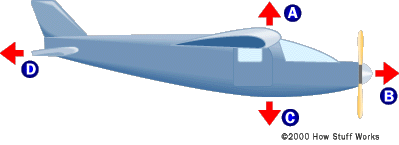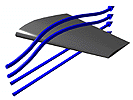![]()
When any airplane flies there are always 4 basic forces at work. Lift, Drag, Gravity and Thrust.


Thrust
Thrust is an aerodynamic force that must be
created by an airplane in order to overcome the drag (notice that thrust
and drag act in opposite directions
in the figure above). Airplanes create thrust using propellers, jet engines
or rockets. The A-10 uses 2 jet engines that can push 9,065 pounds a piece.
These engines puch the aircraft forward so that lift can be created over
the wings. A jet engine uses Newton's law's to work. Especially the third
law. The engines push air out the back the reaction is that th eairplane
moves forward.

Lift
Lift is the aerodynamic force that holds an
airplane in the air On airplanes, most of the lift required to keep the plane
aloft is created by the wings lift is created by air that is moved across
the wings. As air moves over the wing it must move faster over the top than
the bottom. Faster moving fluids have less pressure. This causes there to
be less pressure on top of the wing so the plane can go up.


THis is the equation for lift.
Drag
Drag is an aerodynamic force that resists the
motion of an object moving through a fluid.The amount of drag
that is experiences depends on a few factors, such as the size of the airplane,
the speed of
the airplane and the
density of the air. There are three kinds of drag, parasite drag,
form drag, and skin friction.
Weight
This one is the easiest. Every object on earth
has weight. Gravity pulls everything to its center at 9.8m/s
![]()
[HOME][FACTS][PHYSICS][PICS][BIBLIOGRAPHY]